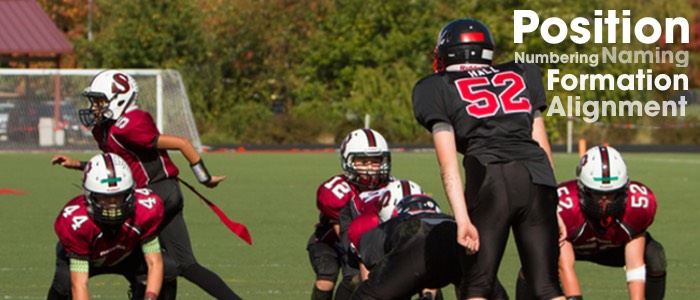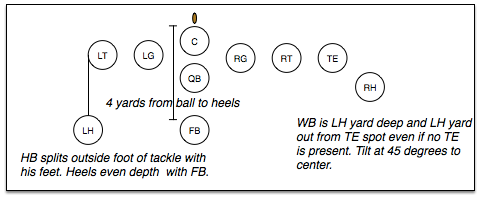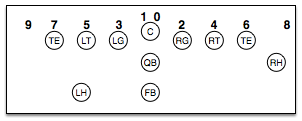Positions, Formations, and Alignment

Let's talk about the basic positions, formations, alignment, and numbering terminology that I like to use for the Wing-T.
Formation and Alignment

The traditional Wing-T formation includes:
- A single tight-end (TE)
- A single split-end or wide receiver (WR)
- A quarterback under center (QB)
- A fullback behind the QB
- Two halfbacks (LH and RH) or wingbacks (you might also just call them "running backs"), with the TE (strong) side halfback in the wing position and the weak-side HB in a halfback position.

There are many variations on this formation, and as you'll see later there are opportunities to run the same play series from different starting formations. The Left formation is the flip of the Right formation, placing the TE on the left side and the RH back in the halfback position.
The default offensive line spacing rules are as follows:
- The center will always break from huddle first (if the team huddles), spring to the ball and get into his stance ready to snap.
- The guards align their inside foot to a two feet split from the near foot of the center. They line up with the maximum allowable depth from the center, which means their helmet must at least be up as far as the hip of the center while he is in his stance. Teach the guards to get into their squat ready to enter a three-point stance then look to the inside. If they are looking at the hip of the center then they have proper depth.
- The other linemen then line up with two feet splits with the same depth as the next lineman to the inside. Same depth means that when he gets into his three-point stance his hand will be planted at approximately the same depth as the next lineman to the inside. This means that a shorter lineman may have his heels closer to the line than a taller lineman.
Note: I like to see this depth in spacing on the offensive line to allow for proper angle blocking and to ensure that the lineman is able to get to his second step before making contact.

The backfield spacing should be as follows:
- The QB is on the mid-line directly behind the center.
- The FB is on the mid-line directly behind the quarterback with his heels four yards behind the football. The Wing-T relies on this close position with fast hitting plays (e.g., Trap, Down) to get the FB to the hole quickly.
- When the HB is aligned in the halfback position he will have the same depth as the FB and will align on the outside foot of the tackle. The tackle's outside foot should split the WB’s feet. When the HB is aligned in the wingback position he will be 1 yard deep and 1 yard outside the TE position. This is true even if there is no TE present.
These alignment rules also apply to player positioning with motion because in many cases motion is being used to move a player to a "normal" starting position for a given play. For example, a coach can call Down from the Right or Rose formation and will usually use Red motion to put the back-side halfback in the correct position for the fake down sweep action. Whether the halfback is starting from the WB or HB position, he should get himself to the proper position at snap. This requires practice and coordination between the backs and QB.
Point of Attack Numbering

I number points of attack as being over specific offensive linemen with odd numbers on the left and even on the right. I took this convention from Coach Rich Erdelyi, former offensive coordinator at Carnegie Mellon University.
You must maintain consistent spacing and alignment for the offensive line and backfield in order to succeed with the Wing-T. Use cones and a line hose to help instill consistency, and have all coaches vigilantly monitor this in all phases of practice including individual drills, group work, and team drills.
Play Naming
The Wing-T is a series based offense and not simply a collection of plays. This Wing-T is loosely based on the classic Wing-T that was prominent in the 50s and 60s but uses different terminology. Borrowing from more recent innovations in the Wing-T such as the system recently in use at Carnegie Mellon, I include information about the running back and the point of attack in the calling convention.

Along with the points of attack, each back is assigned a number (quarterback = 1, left halfback = 2, fullback = 3, and right halfback = 4). You will be able to know the key details of most plays by their names alone. For example:
FORMATION MOTION BACK-HOLE PLAY
RIGHT RED 36 DOWN
RIGHT: Formation call, in this case the Right formation with TE on right and left wingback in halfback position.
RED: Red motion, which is left halfback moving to the right.
First Digit (3): The fullback is the ball carrier
Second Digit (6): The back will advance to the 6 point of attack, just over the TE.
Play (Down): The play name, will often be a combination of a series name and play type.
There are some exceptions to this numbering system to align with most Wing-T calling system conventions. When there is a boot or pass action off a base play, a tag will be used to signify the play without changing the numbering for the underlying play. For example, the play "Rose 28 Buck Sweep Boot Left" is actually the quarterback boot/waggle play to the weak-side. The play "Left 37 Down Pass" is the play action pass off the 37 Down play.